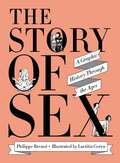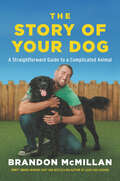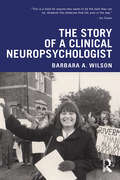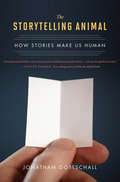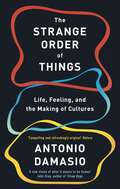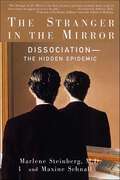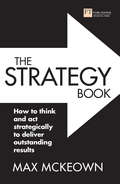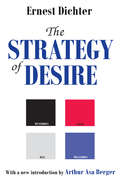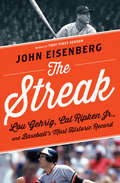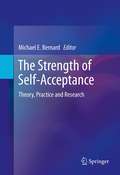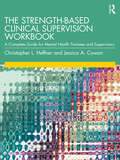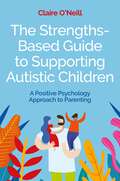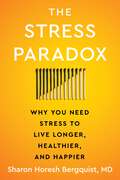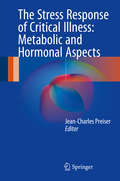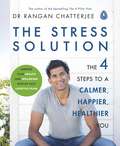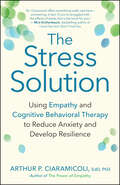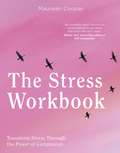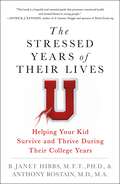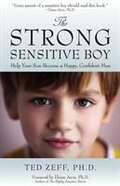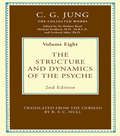- Table View
- List View
The Story of Sex: A Graphic History Through the Ages
by Philippe Brenot Laetitia Coryn Will McmorranThe first graphic history of sex chronicles sexuality and human intimacy through the ages, from our primate pasts to our robotic futures.Humans have had sex on the brain since pre-civilization either for pleasure, power, revenge, a desire for children, or simply because it isn't allowed. Today, sex is all around us but it's rarely explained and almost never taught. In The Story of Sex, sexologist Phillipe Brenot combines anthropology, sociology, psychology and history with witty comics by Latetita Coryn for an in-depth explanation of this essential aspect of humanity. Organized chronologically into sections like Babylon: Free Love, The Middle Ages: Heaven and Hell, and The 20th Century: Sexual Liberation, Brenot explores what eroticism really is, how our ancestors behaved sexually, when the first couple was established, how superstition and morality laws shaped sexuality, the use of pornography in the digital age, and how some ancient civilizations were far ahead of their time when it came to gender equality.Full of fascinating details like Cleopatra's invention of the vibrator and a Dutch shopkeeper's accidental discovery of the existence of sperm--all accompanied by hilarious comics and dialogue--The Story of Sex is informative, unique, and entertaining book.
The Story of Your Dog: A Straightforward Guide to a Complicated Animal
by Brandon McMillanGET TO KNOW YOUR DOG. Renowned expert dog trainer and bestselling author of Lucky Dog Lessons Brandon McMillan unpacks the unique and often misunderstood 15,000-year evolutionary history governing a dog’s every move.Most dog owners know the truth—their dogs are totally incompatible with the modern world. Instincts like herding, chasing, and protecting have no natural outlet and frequently result in chewing, barking, nipping, jumping, lunging, and worse. However, as McMillan argues in these pages, the solution isn’t as simple as mastering “sit” and “stay.” No matter what kind of dog you have, no matter how old or young or well trained or well-bred, your beloved companion is strongly influenced by his DNA. The result of these genetic distinctions shows up in every inch and action—from the size and shape of a dog’s head (and the brain inside it) to the length and curve of his tail, from the texture of her fur to the webbing (or lack of webbing) between her toes. It’s in their lung capacity, their tolerance for heat and cold, their appetites for food and exercise, and whether and how they bark. It goes beyond their structure and deep into their psychological profiles. Perhaps you’re lucky enough to have a dog with more than a few breeds mixed in, which makes this information all the more crucial to know and understand. In The Story of Your Dog, McMillan breaks down why your dog acts the way it does, so you can train better and easier, with fewer missteps and miscommunications, and bond in ways you never thought possible. It is an invitation to get to know the sometimes frustrating but always incredible dog at the other end of the leash.
The Story of a Clinical Neuropsychologist
by Barbara A. WilsonFrom a disadvantaged childhood to becoming one of our best-loved clinical neuropsychologists, this exceptional book tells the life story of Barbara A. Wilson, who has changed the way we think about brain injury rehabilitation. Barbara’s story shows how it is possible to have a fulfilling career alongside a successful family life, even when faced with the deepest of personal tragedies; the death of her adult daughter Sarah. Clinical and neuropsychologists will recognise Barbara’s influence on rehabilitation practice and her tireless aim to get what is best for people needing neuropsychological rehabilitation. It will inspire those with brain injury and their families who may struggle to make life meaningful, as well as encourage readers to stick to their beliefs and triumph in the face of obstacles.
The Storytelling Animal: How Stories Make Us Human
by Jonathan Gottschall&“Insightful...draws from disparate corners of history and science to celebrate our compulsion to storify everything around us.&”—The New York Times Book Review Humans live in landscapes of make-believe. We spin fantasies. We devour novels, films, and plays. Even sporting events and criminal trials unfold as narratives. Yet the world of story has remained an undiscovered and unmapped country. It&’s easy to say that humans are &“wired&” for story, but why? In this delightful, original book, Jonathan Gottschall offers the first unified theory of storytelling. He argues that stories help us navigate life&’s complex social problems—just as flight simulators prepare pilots for difficult situations. Storytelling has evolved, like other behaviors, to ensure our survival. Drawing on the latest research in neuroscience, psychology, and evolutionary biology, Gottschall tells us what it means to be a storytelling animal. Did you know that the more absorbed you are in a story, the more it changes your behavior? That all children act out the same kinds of stories, whether they grow up in a slum or a suburb? That people who read more fiction are more empathetic? Of course, our story instinct has a darker side. It makes us vulnerable to conspiracy theories, advertisements, and narratives about ourselves that are more &“truthy&” than true. National myths can also be terribly dangerous: Hitler&’s ambitions were partly fueled by a story. But as Gottschall shows, stories can also powerfully change the world for the better. We know we are master shapers of story. The Storytelling Animal finally reveals how stories shape us. &“Lively.&”—San Francisco Chronicle &“Absorbing.&”—Minneapolis Star Tribune &“One of my favorite evolutionary psych writers—always insightful and witty.&”—Steven Pinker
The Strange Order Of Things: Life, Feeling and the Making of Cultures
by Antonio Damasio'Damasio undertakes nothing less than a reconstruction of the natural history of the universe ... [A] brave and honest book' The New York Times Book ReviewThe Strange Order of Things is a pathbreaking investigation into homeostasis, the condition of that regulates human physiology within the range that makes possible not only survival but also the flourishing of life. Antonio Damasio makes clear that we descend biologically, psychologically and even socially from a long lineage that begins with single living cells; that our minds and cultures are linked by an invisible thread to the ways and means of ancient unicellular existence and other primitive life-forms; and that inherent in our very chemistry is a powerful force, a striving toward life maintenance that governs life in all its guises, including the development of genes that help regulate and transmit life.The Strange Order of Things is a landmark reflection that spans the biological and social sciences, offering a new way of understanding the origins of life, feeling and culture.
The Stranger in the Mirror: Dissociation—The Hidden Epidemic
by Maxine Schnall Marlene SteinbergDiscover groundbreaking findings on a hidden epidemic -- and why it so often is misdiagnosed.You peer into the mirror and have trouble recognizing yourself. You feel as if you're going through the motions of life or you're watching a movie of yourself.These are all symptoms of dissociation -- a debilitating psychological condition involving feelings of disconnection that affects 30 million people in North America and often goes untreated. The Stranger in the Mirror offers unique guidelines for identifying and recovering from dissociative symptoms based on Dr. Marlene Steinberg's breakthrough diagnostic test. Filled with fascinating case histories of people with multiple personalities, this book provides enlightening insights into how all of us respond to trauma and overcome it. Her innovative method of treatment will benefit anyone in search of a healthier sense of self and a heightened capacity for joy.
The Strategic Dialogue: Rendering the Diagnostic Interview a Real Therapeutic Intervention
by Giorgio Nardone Alessandro SalviniThe Strategic Dialogue is a fine strategy by which one can achieve maximum results with minimum effort. It was developed through a natural evolutionary process from previous treatments for particular pathologies, and composed of therapeutic stratagems and specific sequences of ad hoc maneuvres constructed for different types of problems. This book represents both the starting and finishing line of all of the research, clinical practice, and managerial consulting performed by the authors over a fifteen year period at the Centro Terapia Strategica of Arezzo (Strategic Therapy Center). This work can be referred to as the finishing line because the Strategic Dialogue, an advanced therapeutic method of conducting a therapy session and inducing radical changes rapidly in the patient, represents the culmination of all that has been achieved so far in the field.
The Strategic Grant-seeker: A Guide To Conceptualizing Fundable Research in the Brain and Behavioral Sciences
by Judy IllesAn understanding of each of the critical components of the funding process is key to meeting the challenges posed by the increasingly intense competition for research funds. This book is a vital tool for those who want to build and maximize their grant support. Although many publications provide valuable information about proposal preparation, few cover the full spectrum of issues--from planning through execution--in the funding process. The book leads off with a discussion of the relationship between researchers and the funding environment, features of good short- and long-range funding plans, characteristics of funding organizations in terms of funding power, mission, and priorities, and the manner in which funding information is disseminated. Succeeding chapters focus on the actual development of the many different types of opportunities--research projects, multicomponent research programs, career development and training programs, and small business innovation research. These chapters emphasize conceptualizing an idea, optimizing the researcher-sponsor match, and testing the concept for competitiveness. Further chapters deliver strategies for translating research ideas into written proposals, preparing administrative sections and communicating with a sponsor. The final chapters are dedicated to the outcomes of the proposal process: reviews, rebuttals, and resubmissions; and to progress reports and future proposals for maintaining and building on funding. Flowcharts, examples, and summary tables are used throughout the text to highlight key points.
The Strategy Book: How To Think and Act Strategically To Deliver Outstanding Results
by Max MckeownThinking strategically is what separates managers and leaders. Learn the fundamentals about how to create winning strategy and lead your team to deliver it. From understanding what strategy can do for you, through to creating a strategy and engaging others with strategy, this book offers practical guidance and expert tips. It is peppered with punchy, memorable examples from real leaders winning (and losing) with real world strategies.
The Strategy of Desire
by Ernest DichterErnest Dichter is famous as one of the founding fathers of motivational research. In applying the social sciences to a variety of problems, Dichter emphasized new approaches to problem solving, advertising, politics, and selling, and issues of social significance such as urban renewal, productivity, and drug addiction. As an author and corporate adviser, he used psychoanalytic theory and depth interviewing to uncover unconsciously held attitudes and beliefs. He goal was to help explain why people act the way they do and how positive behavioral change might be achieved. In The Strategy of Desire, Dichter both counters the argument that motivational research amounts to manipulation, and shows how the understanding and modification of human behavior is necessary for progress.Dichter's survey and analysis of behavior ranges widely. He examines everyday matters of product choice, as well as such broad civic issues as voter participation, religious toleration, and racial understanding. He shows that in order to achieve socially constructive goals, it is necessary to move beyond theological exhortation, which takes an unrealistic view of human morality, as well as beyond the limits of empirically oriented social science research, which only deals in appearances. Dichter sees human action as rooted in irrational and often unconscious motivation, which can usually be uncovered if the correct approach is used. In his consumer research, he analyzes the nonutilitarian importance of objects in everyday life, as well as how products and materials become bound with emotional resonance or acquire different meanings from different contexts or points of view. Dichter shows that success depends on the satisfaction of desires and a movement beyond the ethic of work and saving. Arguing that in an increasingly technological world, progress and social harmony are materially based, he advocates a morality of the good life in which prosperity and leisure lead to greater h
The Streak: Lou Gehrig, Cal Ripken Jr., and Baseball's Most Historic Record
by John Eisenberg&“A line-drive hit of a book&” about the Iron Horse and the Iron Man—two legends from two eras of baseball—and the nature of human endurance (The Wall Street Journal).When Cal Ripken Jr. began his career with the Baltimore Orioles at age twenty-one, he had no idea he would someday beat the historic record of playing 2,130 games in a row, a record set forty-two years before by the fabled &“Iron Horse&” of the New York Yankees, Lou Gehrig. Ripken went on to surpass that record by 502 games, and the baseball world was floored. Few feats in sports history have generated more acclaim. But the record spawns an array of questions. When did someone first think it was a good idea to play in so many games without taking a day off? Who owned the record before Gehrig? Whose streak—Gehrig&’s or Ripken&’s—was the more difficult achievement? Through probing research, meticulous analysis, and colorful parallel storytelling, The Streak delves into this impressive but controversial milestone, unraveling Gehrig&’s at-times unwitting pursuit of that goal (Babe Ruth used to think Gehrig crazy for wanting to play every game), and Ripken&’s fierce determination to stay in the lineup and continue to contribute whatever he could even as his skills diminished with age. So many factors contribute to the comparisons between the two men: the length of seasons, the number of teams in the major leagues, the inclusion of nonwhite players, travel, technology, medical advances, and even media are all part of the equation. This is a book that captures the deeply American appreciation—as seen in the sport itself—for a workaday mentality and that desire to be there for the game every time it called.&“It tackles the allure of human endurance and the pitfalls of fame, but it is mostly a baseball book for baseball fans. It succeeds as both a thorough accounting and a love note to the game.&”—The Washington Post
The Strength of Self-Acceptance
by Michael E. BernardSelf-acceptance is recognized in diverse schools of Christian and Eastern theology as well as in various schools of counseling and psychotherapy (e.g., Humanistic, Rational-Emotive Behavior Therapy, Cognitive Behavior Therapy, Acceptance Commitment Therapy) as a major contributor to mental health, life satisfaction and wellness. A review of the professional literature reveals there is no text that spells out how different theologies, theories of personality and approaches to counseling and therapy conceptualize self-acceptance and how this concept is interrelated to other aspects and constructs of spirituality and psychological functioning (e.g., flexibility, mindfulness). Additionally, the field of positive psychology, which studies the character strengths and virtues that help individuals to experience well-being and to flourish, has largely ignored the concept of self-acceptance.
The Strength-Based Clinical Supervision Workbook: A Complete Guide for Mental Health Trainees and Supervisors
by Christopher L. Heffner Jessica A. CowanSupervision is the cornerstone of clinical training across all types of mental health providers. It facilitates the growth of mental health trainees and maintains the integrity of the field of mental health services by ensuring the competency of clinicians. However, the process can be complex and potentially confusing for both supervisors and trainees at any stage of their development or post-licensure career. Utilizing strength-based approaches is crucial to the success of supervision. This workbook facilitates a collaborative and strength-based approach to clinical supervision that both supervisors and trainees can use during the entire course of supervision, or for specific goals related to supervision. Each chapter of this workbook contains information and activities specific to both the trainee and supervisor to facilitate dialogue about individual and combined strengths, areas for growth, and goals for collaborative work. This is an essential start-to-finish guide addressing the entire supervision process, from preparing for the first session to conducting the last session, and everything in between.
The Strengths-Based Guide to Supporting Autistic Children: A Positive Psychology Approach to Parenting
by Claire O'Neill'Being strength-aware has brought many moments of joy to our family life. It is this potential for growth and joy that I now want to share in this book'This flexible, dip-in-dip-out guide will introduce you to the strengths-based approach that is helping autistic children and their families to thrive. By focusing on how to identify, develop and use your child's strengths to support them throughout childhood and into adolescence, this transformative approach is here to show you and your child that their unique character-strengths can empower them and shape their future.Claire O'Neill combines her personal experience as an autistic person and mother to autistic children with her expert knowledge as a professional working with autistic young people to demonstrate the value of a strengths-based approach.With step-by-step instructions on how parents and teachers can incorporate this approach easily into family and school life, Claire also offers a variety of specific tips, tricks and engaging activities to provide ongoing support for parents and teachers alike.
The Stress Paradox: Why You Need Stress to Live Longer, Healthier, and Happier
by Sharon Horesh BergquistA paradigm-shifting approach to wellness that reveals how the right levels of stress are actually good for you and how stress can help you unlock the body’s natural ability to stave off aging, prevent disease, and improve metabolic health.What if we’ve gotten stress wrong?There’s a breakthrough happening in the study of wellness and longevity. We know that excessive stress can be toxic, but emerging new research reveals that too little stress is just as bad for you as too much.Dr. Sharon Bergquist, a pioneering physician and leading stress researcher, is at the forefront of this movement. In The Stress Paradox, she explains that our bodies are designed to heal and repair themselves, but we need the right amount and type of stress to rejuvenate at a cellular level.Many modern comforts have inadvertently increased our risk of mental and physical illness by causing us to underutilize our inherited response to challenges. Our need for stress is so deeply embedded in our genes that you can’t achieve good health without it! Dr. Bergquist reveals how to optimize five key stressors to maximize mental, emotional, and physical resilience and reap a host of health benefits, from staving off dementia to increasing the years of your life. These simple lifestyle changes can keep your mind sharp, improve your mood, increase energy and metabolism, support a healthy gut, maintain a healthy weight, and decrease your risk of serious diseases like cancer, heart disease, type 2 diabetes, and Alzheimer’s.Eating more plant “toxins” in foods like vegetables, dark chocolate, and spicesExercising with intermittent bursts of intense movementEngaging in heat and cold therapy to awaken your body’s ancient healing pathwaysFasting most effectively for your circadian biologyChallenging yourself mentally and emotionally while managing unhealthy stress levels Rooted in cutting-edge science and complete with customizable protocols, workouts, and recipe templates, The Stress Paradox is an accessible life-changing roadmap to dramatically increase health, happiness, and longevity.
The Stress Response of Critical Illness: Metabolic and Hormonal Aspects
by Jean-Charles PreiserThis book demonstrates how the latest insights into the physiopathology of the stress response can be integrated into clinical practice. The topic is particularly relevant since the metabolic changes triggered by acute stress, including adaptive responses such as resistance to anabolic signals, have recently been more precisely delineated. The underlying mechanisms of these changes are also now better understood. The authors analyse how these advances could result in better management and more effective prevention of the long-term clinical consequences of the alterations occurring during the acute phase. An international panel of respected experts discusses these topics and describes the management of some common clinical conditions.
The Stress Solution: The 4 Steps to a Calmer, Happier, Healthier You
by Dr Rangan ChatterjeeFROM THE SUNDAY TIMES BESTSELLING AUTHOR OF HAPPY MIND, HAPPY LIFE 'One of the most influential doctors in the UK (...) I could talk to Rangan all day (...) he's amazing'- Chris EvansBecome a calmer, happier and healthier you with Dr Rangan Chatterjee's The Stress Solution. In this book, Dr Rangan Chatterjee, draws on two decades of practice to show you how to make easy-to-follow and sustainable health and lifestyle improvements to your everyday life. Top tips include:· How to breathe to feel happier· How to schedule in "me time"· How to become less addicted to your phone· How to find and ignite your passionAt no extra cost, learn how to slow down and feel calmer and more in control of your life by investing in your long-term health.'Small changes make a big difference - we can all benefit from reading this' - Jamie Oliver
The Stress Solution: Using Empathy and Cognitive Behavioral Therapy to Reduce Anxiety and Develop Resilience
by Arthur P. Ciaramicoli, EdD, PhDTherapeutic tools for fighting the anxiety, fear, and depression caused by stress “We work too much, sleep too little, love with half a heart, and wonder why we are unhappy and unhealthy,” writes clinical psychologist Arthur Ciaramicoli. In The Stress Solution, Ciaramicoli provides readers with simple, realistic, powerful techniques for using empathy and cognitive behavioral therapy to perceive situations accurately, correct distorted thinking, and trigger our own neurochemistry to produce calm, focused energy. He developed this approach over thirty-five years of working with clients struggling with depression, anxiety, and addictions. Over and over again, he has helped sufferers overcome old hurts and combat performance anxiety, fears, and excessive worry. Ciaramicoli’s pioneering approach offers new promise to readers facing a variety of stress-based concerns.
The Stress Workbook: Transform Stress Through the Power of Compassion
by Maureen CooperStress is an unavoidable part of life that we will all encounter at various times, be it due to a one-off event such as losing a job or the break-up of a relationship, or from facing long-term difficulties such as working in a stressful environment or caring for someone who is ill. How well we deal with stress will influence the extent to which it affects our lives.Maureen Cooper explains why humans are designed to respond to stress in a certain way and why this can even be helpful at times. She goes on to show how to transform our habitual way of responding to stress by training ourselves in compassion and thereby improving our sense of control and wellbeing.In this workbook, you can learn to manage stress better:· Using tried and tested compassion techniques· Via case studies and practical exercises
The Stress Workbook: Transform Stress Through the Power of Compassion
by Maureen CooperStress is an unavoidable part of life that we will all encounter at various times, be it due to a one-off event such as losing a job or the break-up of a relationship, or from facing long-term difficulties such as working in a stressful environment or caring for someone who is ill. How well we deal with stress will influence the extent to which it affects our lives.Maureen Cooper explains why humans are designed to respond to stress in a certain way and why this can even be helpful at times. She goes on to show how to transform our habitual way of responding to stress by training ourselves in compassion and thereby improving our sense of control and wellbeing.In this workbook, you can learn to manage stress better:· Using tried and tested compassion techniques· Via case studies and practical exercises
The Stressed Years of Their Lives: Helping Your Kid Survive and Thrive During Their College Years
by Dr. B. Janet Hibbs Dr. Anthony RostainFrom two leading child and adolescent mental health experts comes a guide for the parents of every college and college-bound student who want to know what’s normal mental health and behavior, what’s not, and how to intervene before it’s too late. “The title says it all...Chock full of practical tools, resources and the wisdom that comes with years of experience, The Stressed Years of their Lives is destined to become a well-thumbed handbook to help families cope with this modern age of anxiety.”— Brigid Schulte, Pulitzer Prize-winning journalist, author of Overwhelmed and director of the Better Life Lab at New AmericaAll parenting is in preparation for letting go. However, the paradox of parenting is that the more we learn about late adolescent development and risk, the more frightened we become for our children, and the more we want to stay involved in their lives. This becomes particularly necessary, and also particularly challenging, in mid- to late adolescence, the years just before and after students head off to college. These years coincide with the emergence of many mood disorders and other mental health issues.When family psychologist Dr. B. Janet Hibbs's own son came home from college mired in a dangerous depressive spiral, she turned to Dr. Anthony Rostain. Dr. Rostain has a secret superpower: he understands the arcane rules governing privacy and parental involvement in students’ mental health care on college campuses, the same rules that sometimes hold parents back from getting good care for their kids. Now, these two doctors have combined their expertise to corral the crucial emotional skills and lessons that every parent and student can learn for a successful launch from home to college.
The Strong, Sensitive Boy
by Ted ZeffYour son may be one of the 20 percent of all boys with a finely tuned nervous system. Our sensitive boys tend to be creative, kind, and gentle, appreciating beauty and feeling love deeply. Therefore, it's particularly challenging for sensitive boys to grow up in a culture where boys are taught to act tough, aggressive, and unemotional.
The Strongest Heart
by Saadia FaruqiFrom beloved middle grade author Saadia Faruqi comes a poignant exploration of the impact of mental illness on families—and the love and hope that it takes to begin telling a different tale. Mo is used to his father’s fits of rage. When Abbu's moods shake the house, Mo is safe inside his head, with his cherished folktales: The best way to respond is not to engage. Apparently, his mama knows that too—which is why she took a job on the other side of the world, leaving Mo alone with Abbu.With Mama gone, the two move to Texas to live with Mo’s aunt and cousin, Rayyan. The two boys could not be more different. Rayyan is achievement-driven and factual; Mo is a “bad kid." Still, there is a lot to like about living in Texas. Sundays at the mosque are better than he’d expected. And Rayyan and his aunt become a real family to Mo.But even in a warm home and school where he begins to see a future for himself, Mo knows that the monster within his father can break out and destroy their fragile peace at any moment…
The Structural Design of Language
by Thomas S. Stroik Michael T. PutnamAlthough there have been numerous investigations of biolinguistics within the Minimalist Program over the last ten years, many of which appeal to the importance of Turing's Thesis (that the structural design of systems must obey physical and mathematical laws), these studies have by and large ignored the question of the structural design of language. They have paid significant attention to identifying the components of language - settling on a lexicon, a computational system, a sensorimotor performance system and a conceptual-intentional performance system; however, they have not examined how these components must be inter-structured to meet thresholds of simplicity, generality, naturalness and beauty, as well as of biological and conceptual necessity. In this book, Stroik and Putnam take on Turing's challenge. They argue that the narrow syntax - the lexicon, the Numeration, and the computational system - must reside, for reasons of conceptual necessity, within the performance systems. As simple as this novel design is, it provides, as Stroik and Putnam demonstrate, radical new insights into what the human language faculty is, how language emerged in the species, and how language is acquired by children.
The Structure and Dynamics of the Psyche: Structure And Dynamics Of The Psyche (Collected Works of C. G. Jung #47)
by C. G. JungThe Structure and Dynamics of the Psyche first appeared in the Collected Works in 1960. In this new edition bibliographical citations and entries have been revised in the light of subsequent publications in the Collected Works, and essential corrections have been made. The book traces an important line of development in Jung's thought from 1912 onwards. The earliest of the papers elaborates Freud's concept of sexual libido into that of psychic energy. In those that follow we see how, Jung, discarding one by one the traditional 'philosophical' hypotheses, gradually arrived at a concept which is even more controversial than psychic energy was in its day ^DDL namely, psychic reality. The book contains the first mention of the archetype in Jung's writings as well as his later views on its nature. There is also a valuable account of the therapeutic uses of 'active imagination' first described in an essay written in 1916.
